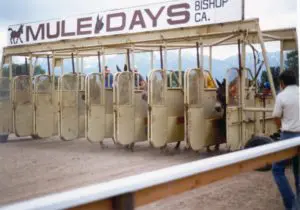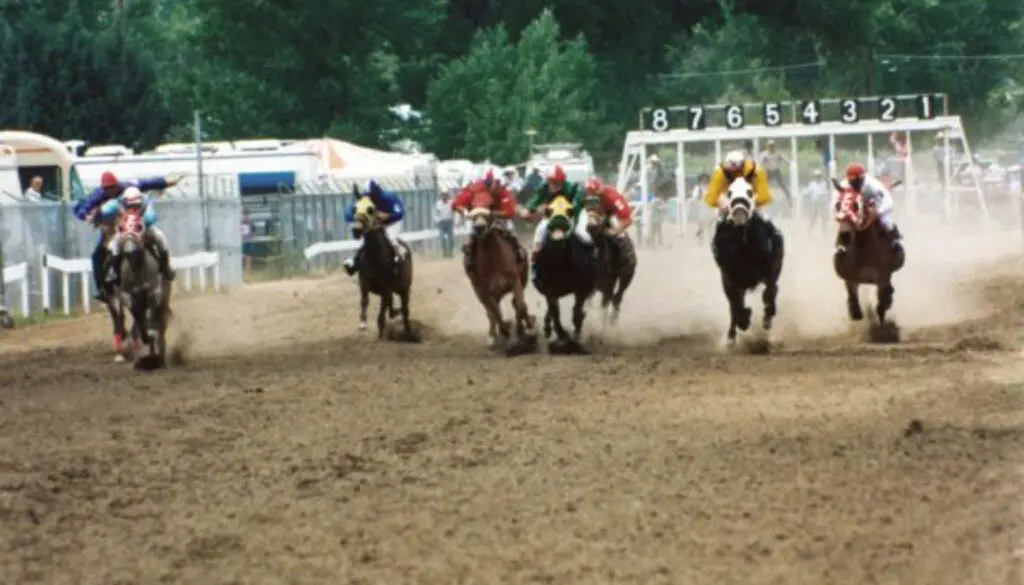MULE CROSSING: Racing Mules
By Meredith Hodges
 Racing, the Sport of Kings has intrigued people for hundreds of years. Perhaps it’s the beauty of running horses, or maybe the way your heart swells with excitement as they come down the home stretch, or it could just be the money. But whatever the reason, millions flock to the racetracks each year to enjoy this magnificent sport. Over the years, racing has expanded to include not only the Thoroughbreds and Standardbreds, but Appaloosas, Arabians, and Quarter Horses as well. During the past three decades, mules have emerged onto the racetrack to take their place in making racing history.
Racing, the Sport of Kings has intrigued people for hundreds of years. Perhaps it’s the beauty of running horses, or maybe the way your heart swells with excitement as they come down the home stretch, or it could just be the money. But whatever the reason, millions flock to the racetracks each year to enjoy this magnificent sport. Over the years, racing has expanded to include not only the Thoroughbreds and Standardbreds, but Appaloosas, Arabians, and Quarter Horses as well. During the past three decades, mules have emerged onto the racetrack to take their place in making racing history.
Although mule racing has just begun to take hold as a national sport, it had its beginnings in the Eastern Sierra Nevada Mountains of California in 1851, when Captain Boling’s cavalry troop was forced to halt for two months in the Yosemite Valley. Horse racing was one of the major sports used to keep up the spirits of the men during this unexpected respite. Army mules were included in these races to add to the entertainment. Much to the chagrin of some of the horse owners, the mules could actually beat some of the cavalry’s favorite mounts. Captain Boling purchased one Maltese, Kentucky-blooded mule (known as The Vining Mule). He was particularly impressed and bought him for one thousand dollars in gold from Lee Vining. He then went on to make many more thousands in match races with this mule against horses. To quote from the official racing program: “The Indian war of 1851 was the catalyst that started the first running of mules in California.”
 The first actual pari-mutuel mule meet was held in Bishop, California in July of 1978. Exacting conditions demanded discreet organization and one of the first necessities was a condition rulebook, which was put together by Paul Voorhees of Bishop, California. On completion of the condition (rule) book, the A.M.A. (American Mule Association) was designated as the official registry for all mules entered in pari-mutuel races. These pari-mutuel mules had to carry an official A.M.A. tattoo. There has been a lot of cooperation among the A.M.A., Racing Board, and mule owners over the years for the promotion of mule racing, and thus, the widespread expansion of this relatively new sport.
The first actual pari-mutuel mule meet was held in Bishop, California in July of 1978. Exacting conditions demanded discreet organization and one of the first necessities was a condition rulebook, which was put together by Paul Voorhees of Bishop, California. On completion of the condition (rule) book, the A.M.A. (American Mule Association) was designated as the official registry for all mules entered in pari-mutuel races. These pari-mutuel mules had to carry an official A.M.A. tattoo. There has been a lot of cooperation among the A.M.A., Racing Board, and mule owners over the years for the promotion of mule racing, and thus, the widespread expansion of this relatively new sport.
Match races and Western-style races included at county fairs exhibit the true versatility of the mule. With increased interest, mule racing now assumes the professionalism of horse racing with the introduction of jockeys, trainers, and starting gates. In the early eighties, purses for mule races ranged from $300 to $700 per race in such states as Colorado, Texas, New Mexico, Arizona and Wyoming with pari-mutuel racing in California and Idaho. The Stakes races averaged more per race and match races were run for as much as $5000 per race. Mules ran at such exclusive tracks as Sunland Park in El Paso, Texas and Ruidoso Downs in New Mexico, with an attendance of 300 or more mules shown over these three-day race weekends. In 1985, there was a match race in El Paso, Texas between the defending World Champion Cajun Queen, owned by J.B. Rogers, and an upcoming young mule, Loretta Lynn, owned by Butch Larson. Cajun Queen maintained her status winning the match race and a purse of $2000.
 Mules generally run races of 300 to 350 yards, although there are 220-yard, 440-yard, 660-yard and half-mile races. Like the Quarter Horses, mules tend to run better for the shorter distances. They can clip off 300 yards in 17 seconds or less. At Ruidoso Downs in New Mexico in 1984, 300 mules showed to race in a three-day meet for a total purse of $55,000. The 1985 meet was held at Sunland Park in El Paso, Texas, with the addition of a three-year-old futurity and a mule sale.
Mules generally run races of 300 to 350 yards, although there are 220-yard, 440-yard, 660-yard and half-mile races. Like the Quarter Horses, mules tend to run better for the shorter distances. They can clip off 300 yards in 17 seconds or less. At Ruidoso Downs in New Mexico in 1984, 300 mules showed to race in a three-day meet for a total purse of $55,000. The 1985 meet was held at Sunland Park in El Paso, Texas, with the addition of a three-year-old futurity and a mule sale.
These long-eared sprinters are a breed apart from their ancestors, who were primarily beasts of burden and limited to farm and mine work. Today’s race mules are out of some the finest race-bred Quarter Horse and Thoroughbred mares, and are sired by the finest quality jacks. Because of their careful and curious nature, mules are bit more difficult to train to run straight. The mule races today prove it can be done, and done very well at that! Concerned mule owners opted for a three-year-old futurity to discourage the running of two-years-old. Mules are allowed to run as two-year-olds only after September of their second year and only if their knees have been x-rayed and approved by a veterinarian. The weight carried by a race mule must be a minimum of 140 pounds. The stoutness and sensibility of the mule has made him sounder and more economical to use for racing, with fewer leg problems than experienced with racehorses. The long-lasting durability of the mule has given cause to limit the age of participating race mules to 15 years old.
Despite sterility, race mules sold for $3000 to $10,000. The reason for this is the longevity of their racing life of 12 years and the fact that they are capable of running 2 races a day. With the price of racehorses skyrocketing, racing enthusiasts are showing more and more interest in racing mules and they are now commanding much higher prices. Executives and professionals can see the economic benefits of mule racing and appreciate the more intimate personalities of their investments. There is much to be said for racing mules. It is economically feasible, exciting and sometimes even comical, and the spectators adore them! So satisfy your own curiosity. Come to the mule races near you and see them run!
To learn more about Meredith Hodges and her comprehensive all-breed equine training program, visit LuckyThreeRanch.com, MEREDITH HODGES PUBLIC FIGURE Facebook page, or call 1-800-816-7566. Check out her children’s website at JasperTheMule.com. Also, find Meredith on Pinterest, Instagram, MeWe, YouTube and Twitter.
Covered in TRAINING MULES & DONKEY: A LOGICAL APPROACH TO TRAINING, TRAINING WITHOUT RESISTANCE and EQUUS REVISITED at www.luckythreeranchstore.com.
© 1986, 2016, 2024 Lucky Three Ranch, Inc. All Rights Reserved.




Curtis Schoen
June 14, 2022 @ 10:27 pm
Enjoyed the article. Can a person get a mule that a trainer can’t get to run fast enough to compete?
Meredith
June 22, 2022 @ 4:57 pm
Mules bond to the person who trains them. Some mules are very fast and of racing quality, but the owner must do the training to get the best from them. I do not recommend that people send their mules to trainers. Rather, I suggest that they do the training themselves with the help of a trainer as a coach. This is what I do for people. My program is broken down into such simple steps that anyone can learn to train their own equine…mule, donkey, horse, or whatever.
Michael Farley
September 15, 2022 @ 10:35 am
My name is Mike
I have been involved in race horses for 40 years. I have perfected an INTERVAL TRAINING PROGRAM that really increases a horses potential. I would love to try it on mules and see how they perform. I’m not familiar with a mules earning potential but I’m positive I could develop a mule to perform far beyond his/her current stats.